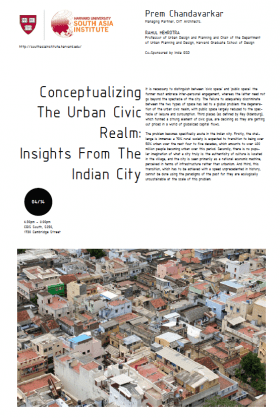Urbanization Seminar
Speaker: Prem Chandavarkar, Managing Partner, CnT Architects.
Chair: Rahul Mehrotra, Professor of Urban Design and Planning and Chair of the Department of Urban Planning and Design, Harvard Graduate School of Design.
It is necessary to distinguish between ‘civic space’ and ‘public space’: the former must embrace inter-personal engagement, whereas the latter need not go beyond the spectacle of the city. The failure to adequately discriminate between the two types of space has led to a global problem: the degeneration of the urban civic realm, with public space largely reduced to the spectacle of leisure and consumption. Third places (as defined by Ray Oldenburg), which formed a strong element of civic glue, are declining as they are getting out priced in a world of globalized capital flows.
The problem becomes specifically acute in the Indian city. Firstly, the challenge is immense: a 70% rural society is expected to transition to being over 50% urban over the next four to five decades, which amounts to over 400 million people becoming urban over this period. Secondly, there is no popular imagination of what a city truly is: the authenticity of culture is located in the village, and the city is seen primarily as a rational economic machine, perceived in terms of infrastructure rather than urbanism. And third, this transition, which has to be achieved with a speed unprecedented in history, cannot be done using the paradigms of the past for they are ecologically unsustainable at the scale of this problem.
The call is being made to respond to this crisis by urgently strengthening the country’s capabilities for urban planning. But the land use plan, which forms a foundation of urban planning, has limited applicability. Bangalore will be used as a case study to compare the impact of land values for the smallest parcel permitted by the land use plan with median incomes of the top to bottom quintiles; the comparison showing that over 40% (a conservative estimate) of the city’s population is out priced by the land use plan. The poor have survived in the Indian city through informal systems of tenure enabled by spaces left by the limited and weak reach of urban planning. The weakness of planning exists at the levels of ideation as well as implementation, and is compounded by the large percentage of building stock that predates master planning. To now extend the reach of urban planning (as it is currently perceived) will set the country on a collision course with social conflict.
Co-sponsored with the India GSD

